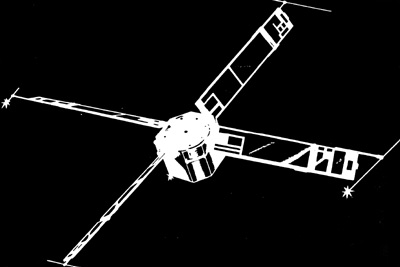Thank you very much for visiting Gunter's Space Page. I hope that this site is useful and informative for you.
If you appreciate the information provided on this site, please consider supporting my work by making a simple and secure donation via PayPal. Please help to run the website and keep everything free of charge. Thank you very much.
Transit-5E 1 (S/N 39)

Transit-5E 1 [JHU/APL]
Three Transit-5B series satellites were launched by Thor-DSV2A Able-Star rockets with piggyback Transit-5E series research satellites. The 5E series were launched to obtain environmental data in the vicinity of the operational orbit of Transit satellites and used solar power. The Transit-5Es, which reached orbit, yielded excelent data.
This series was built on Transit busses based on the Transit 5A series.
Transit-5E 1 featured following systems:
- One oven-controlled oscillator (5 parts in 1011)
- Transmitters: 136 (TM), 162, and 324 MHz
- Omnidirectional particle detectors (3)
- Electron spectrometer
- Proton spectrometer
- Solar cell experiments
- Thermal coating experiment
- Transistor circuit reliability experiment
- Three axis solar attitude detector
- Three axis fluxgate magnetometer
- Command system: Eight on/off commands
- Telemetry: Two 35-channel commutators with some subcommutation of analog information plus 256-bit digital encoder
- Whip and dipole antenna system.
The objectives of Transit-5E 1 were:
- Measure omnidirectional flux of protons and electrons above certain threshold energies in order to determine the temporal variations in the radiation environment.
- Verify information pertinent to radiation effects on various transistors.
- Determine the effectiveness of seven selected thermal coatings.
- Determine the effectiveness of protective coatings on solar cells in preventing degradation due to radiation.
- Backup Satellite Transit-5BN-1 Objective to increase knowledge of the earth's shape and gravitational field.
All 5E-1 launch objectives were met, and the satellite continues to yield excellent data on high-energy particles. Studies thus far completed include:
- Measurement of artificial radiation belt decay.
- Time variations, lifetimes, and response times to magnetic activity of outer zone electrons.
- Day-night distortion of outer radiation belts.
- Loss of particles in the South Atlantic anomaly and their subsequent replenishment at longitudes removed from the anomaly.
- The determination of a nightside magnetospheric configuration based on the observations of trapped electrons in the outer zone.
- The finding of a 27-day cycle (the solar rotation period) in the trapped electron intensities in the outer zone.
- Initial results giving behavior of outer zone electrons during magnetically active periods.
- Tentative understanding of behavior of energetic electrons in outer zone during magnetically quiet periods.
- Study of the effects of a solar high-energy proton event as seen throughout the magnetosphere.
The solar science experiments have contributed materially to numerous studies concerned with the solar spectrum and long and short term variations in solar intensity. Solar data have facilitated development and calibration of solar simulators and have aided in the development of improved solar cell protection devices.
The transistor reliability study included accurate measurements on the effect of radiation on the performance of selected transistors in orbit, and also provided degradation data that were in excellent agreement with theoretical predictions of the electron density which would produce the observed degradation. The measurements also complemented data received from the electron spectrometer experiment.
Satellite 5E-1 fluxgate magnetometer data were used in the detection of one component of transverse hydromagnetic waves. The studies thus far have shown that: (1) the waves appear primarily in the auroral regions; (2) the magnitudes vary between 25 gamma (the lower limit of fluxgate sensitivity) to about 400 gamma, representing about one percent of the main field at the satellite altitude (1 gamma = 10- 5 gauss); and (3) more than 100 disturbances have been found. Satellite 5E-1 provided excellent geodetic data; the satellite longevity resulted in the fulfillment of Objective No. 5.
The 162 MHz transmitter failed on 19 March 1964 and the resultant load change has since allowed only limited operation in battery mode. However, the major satellite experiments were not seriously affected.
Satellite 5E-1 has become one of the most productive satellites ever launched. Data were acquired routinely for over six years and the satellite has functioned for a full solar cycle (11 years).
| Nation: | USA |
|---|---|
| Type / Application: | Experimental |
| Operator: | USN |
| Contractors: | Johns Hopkins University Applied Physics Laboratory (APL) |
| Equipment: | ? |
| Configuration: | Transit-Bus |
| Propulsion: | ? |
| Power: | 4 deployable solar arrays, batteries |
| Lifetime: | +11 years (achieved) |
| Mass: | 59 kg |
| Orbit: | 1078 km × 1129 km, 89.9° |
| Satellite | COSPAR | Date | LS | Launch Vehicle | Remarks | |
|---|---|---|---|---|---|---|
| Transit-5E 1 (S/N 39) | 1963-038C | 28.09.1963 | Va 75-1-1 | Thor-DSV2A Able-Star | with Transit-5BN 1 |
References:
- The Johns Hopkins University, Space Department: Artificial Earth Satellites Designed And Fabricated By The Johns Hopkins University Applied Physics Laboratory
